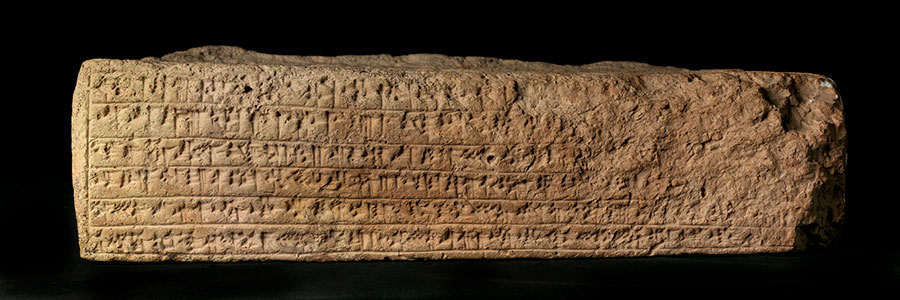

The Babylonian Section’s newest acquisition, a large baked brick with a stamped inscription, illuminates an era of social and religious upheaval throughout the ancient Near East. The inscription is a standard one that celebrates Untash-Napirisha, king of Elam, in what is now Southwest Iran, from ca. 1275–1240 BCE. As translated, it reads (following Dan Potts [1999]):
“I, Untash-Napirisha, son of Humban-Numena, king of Anshan and Susa, desirous that my life be continually one of prosperity, that
the extinction of my lineage not be granted when it shall be judged (?), with this intention I built a temple of baked bricks, a high temple of glazed bricks; I gave it to the god Inshushinak of the Sacred Precinct. I raised a ziggurat. May the work which I created, as an offering, be agreeable to Inshushinak!”
The provenance of the brick is unknown, but Untash-Napirisha built ziggurats at both Susa, the traditional capital of Elam, and at a new foundation he named “City of Untash-Napirisha” (modern Choga Zanbil). Both were built of mud brick with an outer layer of baked bricks. Every 11th row of outer bricks was stamped with an inscription. These were in the Elamite language, but written using Mesopotamian cuneiform. Only the few scribes would have been able to read them.
Both ziggurats were originally dedicated to Inshushinak, patron god of Susa. However, at his new capital, the king soon changed his plans. Like many other monarchs in the Late Bronze Age Near East, he ruled an increasingly complex state with age-old traditions that often impeded administrative innovation. Specifically, he struggled to integrate the highland region of Anshan into a kingdom centered on the Susiana Plain. Although his new city was in the lowlands, he provided it with shrines to the major gods from all parts of his kingdom. Most dramatically, he tore down his first ziggurat there and replaced it with a much more ambitious one that became the largest such structure built in the ancient Near East. He then dedicated it to both Inshushinak and Napirisha, chief god of the highlands of Anshan.
Untash-Napirisha’s success in creating a new focal point for his kingdom is debatable. Elamite unity and power would be a feature of Near Eastern politics over the next century and a half, but the gravitational pull of the old capital proved too strong. After the death of its founder, the City of Untash-Napirisha was virtually abandoned.
The brick was a gift of Tenley M. and Rouyan V. Jones.
